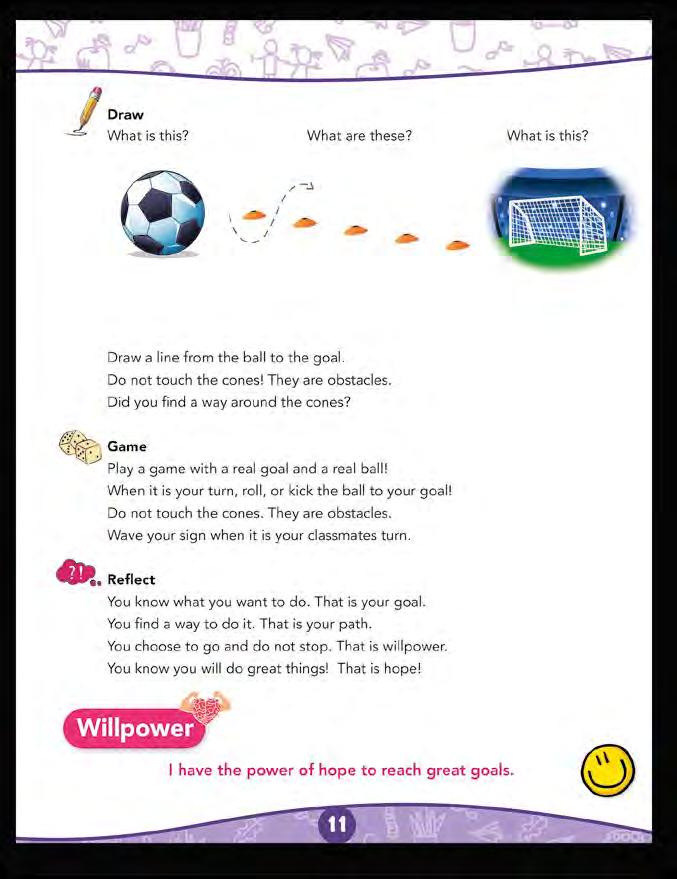
4 minute read
Lesson 1: I Have Hope
Materials
My Best Me textbook, writing and coloring utensils, colored cardstock paper, 1 Popsicle stick per student, ball (big enough to kick), 4 cones
Advertisement
Resources
Introduction Parent: 4yu.info/?i=V598540 Student Worksheet: 4yu.info/?i=V5981301 Template: 4yu.info/?i=V59813011
Motivation

Hope is the belief that life can improve in the future and that we each have the power to act for positive outcomes. Hope is not a feeling, but a mentality that inspires actions that pull a person out of where they are and moves them in the direction of where they want to go. It is possible even for young children to adopt and exercise this optimistic mentality! To do this, students learn what goals are and how they can determine ways to achieve them. Rather than the “If at first you don’t succeed, try, try again!” mantra, more specifically encourage “If at first you don’t succeed, don’t stop, do it differently!” Children are capable of brainstorming different ways to solve problems, and are more likely to encounter success in doing so. Children who use the word “try” weaken their resolve. Think of jumping, do you jump or do you try to jump? It is simple you either jump or you do not. That counts for everything we do in life. We do it! Now, we might miss or fail in the beginning, but we can reach any goals we set if we keep at it. Since hope is often used in an abstract manner and not clearly defined, young students benefit from this lesson’s concrete comparisons, such as moving a ball into a soccer goal. Through visualizing and discussing their goals, making a sign to wave, and reinforcing the concept of hope through a physical activity, you are helping them build their hope through a social-emotional learning process.


Goal
Students will learn about the simplicity and power of hope, (setting goals, finding pathways, and building willpower) why they need it, and how they can apply it.
Observe: Read the first two sentences out loud in an excited and animated voice. Read them again, and have students repeat after you. Your classroom would greatly benefit from an “I can do” atmosphere. Consistently reject words similar to “I can’t!” and “I don’t know how.” Direct their attention to the pictures in the book. Ask them whether they think they can do any of these things someday. Say that with hope they can! Have them circle the ones they hope to do. Comment: Read the first sentence and
Pathways

encourage students to think and share their ideas with the class, one at a time, about other things they would like to do, learn, or experience. Read the remaining sentences in an excited manner. Ask students how they feel, knowing that hope gives them power. Read: Ask students if they ever tried something that did not work or they were unable to do the first few times. What did they end up doing? Did they give up or keep practicing until they were able to do so? (Examples can be riding a bike, jumping rope, reading a book, etc.). Read the sentences in their textbook with them. You could rehearse with them some things they did learn by doing it over and over again (falling and getting back up, eating with a fork, etc.). Create: Ask students what a problem is. Ask students to share examples of problems or challenges they are facing. Explain that we often want to solve problems, which is to fix them or find a way past them. Sometimes the first way does not work. Ask students what they think they should do next? They should do it again, but do it differently! If one way does not work, they can find another way! Repeat: If at first you don’t succeed, do it again! Do it differently! Distribute the copies of the template from 4yu.info/?i=V59813011, Popsicle sticks, crayons, and glue. Point out the text on the papers and read them again. Guide students to color each paper with words. Direct them to glue them to each side of a Popsicle stick with the text facing outwards. Have the class chant the words while waving their signs. Draw: Ask students to identify the pictures. Direct them to set their writing utensil on the ball and trace it along a path they find that leads to the goal - without touching the cones. Ask the final question and affirm their efforts! Play: Announce that the students will work to kick a ball into a goal for real! Have students line up behind a starting cone. Scatter other cones (or various obstacles) throughout the area and point them out as obstacles. Point out their goal (you determine it; it could be the opposite wall or a table). Guide students to go through the course one at a time, and encourage the others to watch, wave their signs and cheer for their teammate. You can also divide them into two groups that run the course simultaneously. Afterwards, have students sit down and discuss how it felt to persist until they achieved their goals. Reflect: Read the sentences. Emphasize the power of their choices.

Willpower
Repeat the Willpower statement as a class. Remind students that HOPE is to have a goal, find a way to that goal, and keep at it until you reach that goal. Decide on hand motions that accompany it. Repeat it with the motions as a class.

